Probably everyone knows what worms are and where they come from.But not everyone can answer what worms are and, most importantly, what damage they can do to the human body.
Characteristics and types of helminthiasis
Helminth infections are a group of human diseases caused by the ingestion of parasitic worms, which colonize a person's internal organs, affecting the tissues and disrupting their normal function.
Parasites can colonize almost any organ: intestines, lungs, gallbladder, liver and even the brain.The name, course, consequences, and symptoms of helminthiasis depend on the type of parasite causing the disease.
But there are some common types of helminthiasis:
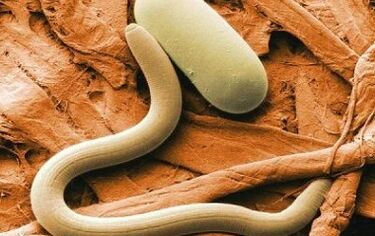
- touch.It is spread directly through contact between infected people.The most common are hymenosis, caused by dwarf tapeworms, and pinworms, caused by pinworms.The parasite crawls out of the rectum and lays eggs on the person's skin.Further distribution is through food and household items.The main causes of contact helminthiasis infections are non-compliance with personal hygiene rules, as well as improper processing of products and non-compliance with storage rules.
- Geoworm disease.Characteristically, no intermediate host is required; the parasite completes its entire life cycle within a single organism.The eggs and larvae of the parasite can only live in the external environment, most commonly in the soil.Very rare species are capable of growing indoors, and most can only grow in soil or water.Children who frequently play in the dirt and farm and ranch workers are most susceptible to soil worm disease.Human infection occurs through consumption of unwashed vegetables and fruits and untreated drinking water.It is possible for worms to enter through ingestion of dust or through the skin.
- Biological helminthiasis.For helminth development, the involvement of an intermediate host, usually an invertebrate, is necessary.Basically, biological helminthiasis is spread by blood-sucking insects.These types of parasites live in the blood of their final host, enter the insect through a bite, then develop inside it, and reach another person through the same bite.But there is also the possibility of eggs and larvae being released into the external environment, as in the case of soil worms.Each type of worm requires its specific type of intermediate host.
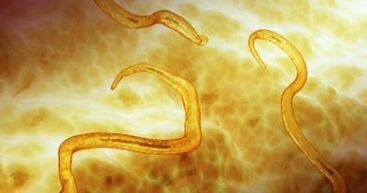
Symptoms and causes of helminthiasis
The clinical symptoms of helminthiasis depend directly on the type of parasite in the human body and its habitat.Depending on the organ affected, the disease presents with various manifestations, which often interferes with accurate diagnosis.
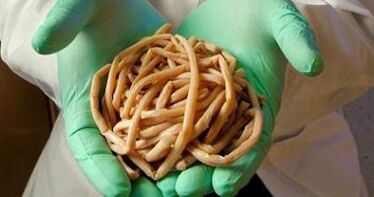
Helminthiasis goes through acute and chronic stages of development.The acute phase lasts no more than 8 weeks, but the chronic phase can last for years.The acute phase is characterized by similar symptoms in all types of helminthiasis, as the immune system immediately reacts to the presence of a foreign body in the body.
With the chronic stage, the symptoms of each specific disease become more specific and cannot be generalized.It all depends on which organ is affected, for example, when the parasite is located in the intestines, typical symptoms are abdominal pain and problems with bowel movements.
Symptoms of helminthiasis:
- Increased body temperature.
- Excessive sweating and swelling.
- Muscle aches and joint pain.
- Diarrhea or, conversely, frequent constipation.
- Dehydration and frequent vomiting.
- Liver, spleen, lymph node enlargement, abdominal distension.
- Rash on human skin.
- Elevated levels of white blood cells.
- Iron deficiency anemia.
- Itching of the skin and anus.
- Nervous system disorders, apathy, irritability, depression.
- Bloody discharge during bowel movements or urination.
- Pancreatitis, jaundice, hepatitis, intestinal obstruction.

Some types of helminthiasis are characterized by an asymptomatic, latent course.This is very dangerous, because after serious injury, a person's internal organs may rupture, and the whole body will inevitably be infected by parasites, leading to serious consequences such as anaphylactic shock or peritonitis.
Particular attention should be paid to manifestations of helminthiasis in children, as they are most at risk.
They are often confused with other illnesses and cause damage to the body.Children's immunity is not fully developed and there are no obvious signs of impairment.
The most common childhood disease is pinworms.Second on the list are various roundworms, which are the most characteristic of childhood diseases.It is necessary to pay attention to the consistency and regularity of stools, the appearance of various rashes, and not to ignore complaints of itching in the anal area.
Main causes of helminthiasis:

- Eat unwashed vegetables, fruits and berries.It is very important to adhere to hygiene and sanitation standards.Products purchased with care; for children, it is recommended to use specialized products for washing fruits and vegetables.Hands must be washed before each meal.
- Meat and fish products.To avoid infections and serious consequences, high-quality heat treatment is required and the products purchased are certified.Monitor whether the storage conditions of prepared semi-finished products meet the requirements.It is not acceptable to consume fish products purchased on the roadside.
- Dirt and sand.This mainly applies to children as they tend to put everything in their mouths.During play, do not let your children eat sand from the sandbox or dirt from the summer house.Any items dropped on the floor or open space are excluded.
Parasite eggs are everywhere around us, so we should pay special attention to personal hygiene to prevent possible parasitic diseases as much as possible.
Classification of parasites
Worms are divided into three categories based on their shape and appearance:
- roundworms.To date, more than 80,000 such worms have been described.They can cause serious damage to the human body and cause a variety of helminth diseases.Roundworms develop through 5 stages, 4 of which are larvae and 1 is an adult.With each transition, the environment or intermediate host changes.The most common representatives:
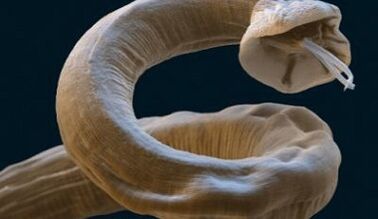
- Roundworms – Cause a disease called ascariasis.This parasite can only live and feed inside the human body.Roundworms are characterized by coughing, in which the larvae are pushed into the person's throat and return to the intestine as mature individuals;
- Pinworms cause pinworm disease in humans and live in the intestines.Once inside the host, they are characterized by indigestion, itching near the anus and, in some cases, genital inflammation, especially in women.
- tapeworm.There are more than 10 orders of tapeworms living in the human body.This is the most common type of parasite and can cause extremely dangerous diseases.They undergo two larval stages of development and reach their final host as adults.They enter the body from an intermediate host, most commonly through the flesh of infected animals.Therefore, in order to prevent this disease, it is important to monitor the correct preparation and selection of meat products.The most common types of worms of this type:
- Tapeworms – Causes tapeworm disease, which is characterized by frequent vomiting, nausea, or loss of appetite;
- Bovine tapeworm is a less dangerous disease but requires very difficult and long-term treatment;
- Echinococcus is a worm that can cause migraines, dizziness, and possibly even seizures.
- Flatworms (flukes).What are flukes?For this type of development, the existence of an intermediate host is required.These parasites are the cause of flukes.The most dangerous breeds in this category:
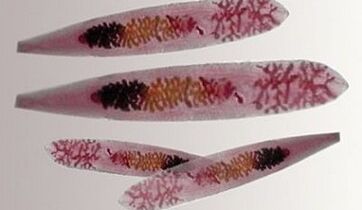
- Posterior fluke disease - occurs when fish (most commonly carp) enters the body, affecting the bile ducts of the liver;
- Schistosomiasis - spread through water and causes schistosomiasis, a very serious disease with extremely serious consequences;
- Paragonimiasis, a type of lung fluke, is the cause of paragonimiasis and can only be contracted by eating crab, crayfish or pork.
All of the human helminth types listed are only a small sample of the types of parasites that currently exist.According to data, there are more than 1 million varieties.
Diagnosis and treatment of helminthiasis
Science does not stand still and a large number of methods have been developed and actively used to identify helminthiasis.Modern methods can accurately determine the type of human parasite and the extent of tissue damage in its location.
Basic methods of diagnosing helminthiasis:
- Microscope.For detection of worm eggs and larvae.These include the methods of Kato, Kalantaryan, and Fulleborn.Individually, each of these methods cannot accurately identify all types of parasites.But in general, they give good results, especially with regard to the intensity of internal parasite transmission.
- Macroscopic wormscope.Most effective in identifying pinworms and roundworms.They help detect parasites in feces by using petri dishes and magnifying glasses.
- Biopsy.If there is a possibility of worm parasitism in human muscle tissue, samples are collected and sent for testing.This method allows you to make the most accurate diagnosis.
- Immunology.They work by examining a patient's blood to detect antibodies to certain types of worms in the body.
- Analysis of bile or duodenal contents.It is used in cases of damage to the liver, gallbladder, and duodenum.
- Instrumental.These include ultrasound, X-ray and computer studies.They are used to determine the extent of damage caused by worms to the human body.Other internal organs are also examined.
Medical methods are used to treat established diseases.However, it has been established that combined therapy using multiple drugs is more effective than monotherapy based on a single anthelmintic.
Worm infections are most commonly treated by taking single-dose tablets containing active ingredients such as levamisole.Choose dosage based on patient age.This helps weaken the parasite.
Then, 3 days later, take medicine containing mebendazole or albendazole.This comprehensive approach significantly speeds up and improves treatment results.
Many times, a person may not even know they have bugs in their body.In this regard, preventive courses with antihelminthic drugs are recommended.This is especially true for preschoolers and pet owners.
Human parasites can cause serious damage to internal organs.Timely diagnosis and treatment can help stop the progression of these diseases and prevent serious consequences.






































